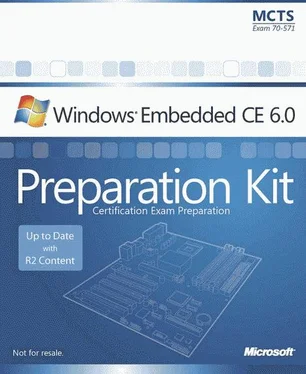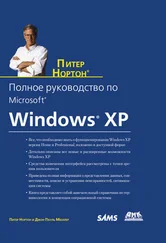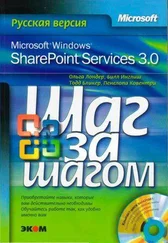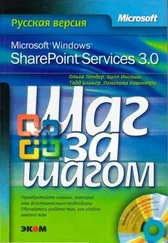Nicolas Besson - Microsoft Windows Embedded CE 6.0 Exam Preparation Kit
Здесь есть возможность читать онлайн «Nicolas Besson - Microsoft Windows Embedded CE 6.0 Exam Preparation Kit» весь текст электронной книги совершенно бесплатно (целиком полную версию без сокращений). В некоторых случаях можно слушать аудио, скачать через торрент в формате fb2 и присутствует краткое содержание. Город: Redmond, Год выпуска: 2008, Издательство: Microsoft, Жанр: Руководства, ОС и Сети, Программы, на английском языке. Описание произведения, (предисловие) а так же отзывы посетителей доступны на портале библиотеки ЛибКат.
- Название:Microsoft Windows Embedded CE 6.0 Exam Preparation Kit
- Автор:
- Издательство:Microsoft
- Жанр:
- Год:2008
- Город:Redmond
- ISBN:нет данных
- Рейтинг книги:5 / 5. Голосов: 1
-
Избранное:Добавить в избранное
- Отзывы:
-
Ваша оценка:
- 100
- 1
- 2
- 3
- 4
- 5
Microsoft Windows Embedded CE 6.0 Exam Preparation Kit: краткое содержание, описание и аннотация
Предлагаем к чтению аннотацию, описание, краткое содержание или предисловие (зависит от того, что написал сам автор книги «Microsoft Windows Embedded CE 6.0 Exam Preparation Kit»). Если вы не нашли необходимую информацию о книге — напишите в комментариях, мы постараемся отыскать её.
Microsoft Windows Embedded CE 6.0 Exam Preparation Kit — читать онлайн бесплатно полную книгу (весь текст) целиком
Ниже представлен текст книги, разбитый по страницам. Система сохранения места последней прочитанной страницы, позволяет с удобством читать онлайн бесплатно книгу «Microsoft Windows Embedded CE 6.0 Exam Preparation Kit», без необходимости каждый раз заново искать на чём Вы остановились. Поставьте закладку, и сможете в любой момент перейти на страницу, на которой закончили чтение.
Интервал:
Закладка:
Kernel Debugger
The Kernel Debugger is the CE software-debugging engine to debug kernel components and CE applications. On the development workstation, you work directly in Platform Builder, such as to insert or remove breakpoints in the source code and run the application, yet you must include support for KITL and debugging libraries (KdStub and OsAxS) in the run-time image so that Platform Builder can capture debugging information and control the target device. Lesson 2, "Configuring the Run-Time Image to Enable Debugging," later in this chapter provides detailed information about system configurations for kernel debugging.
The following target-side components are essential for kernel debugging:
■ KdStubCaptures exceptions and breakpoints, retrieves kernel information, and performs kernel operations.
■ OsAxSRetrieves information about the state of the operating system, such as information about memory allocations, active processes and threads, proxies, and loaded dynamic-link libraries (DLLs).
By using the Kernel Debugger, you can control the entire run-time image as well as individual applications. However, KdStub is a kernel component that receives first-chance and second-chance exceptions, as explained in Chapter 3, "Performing System Programming." If you stop the Kernel Debugger during a session without stopping the target-side KdStub module first and an exception occurs, the run-time image stops responding until you reconnect the debugger, because the Kernel Debugger must handle the exception so that the target device can continue to run.
Debug Message Service
In Platform Builder, when you attach to a KITL-enabled and KdStub-enabled target device, you can examine debug information in the Output window of Microsoft Visual Studio 2005, which Platform Builder obtains from the target device by using the DbgMsg service in the CoreCon infrastructure. Debug messages provide detailed information about the running processes, signal potentially critical issues, such as invalid input, and give hints about the location of a defect in the code that you can then study further by setting a breakpoint and stepping through the code in Kernel Debugger. One of the kernel debugger stub's features is support for dynamic management of debug messages, so you can configure the debugging verbosity without source code modifications. Among other things, you can exclude Timestamps, Process IDs, or Thread IDs, if you display the Debug Message Options window that you can reach through the Target menu in Visual Studio. You can also send the debug output to a file for analysis in a separate tool. On the target device, all debug messages are sent directly to the default output stream handled through the NKDbgPrintf function.
When both Kernel Debugger and KITL are enabled, the debug messages are displayed in the Output window of Visual Studio. If KITL is not available, the debug information is transferred from the target device to the development computer over a serial port configured and used by the OEM adaptation layer (OAL).
Macros for Debug Messages
To generate debug information, Windows Embedded CE provides several debugging macros that generally fall into two categories, debug macros and retail macros. Debug macros output information only if the code is compiled in the debug build configuration (environment variable WINCEDEBUG=debug), while retail macros generate information in both debug and retail build configurations (WINCEDEBUG=retail) unless you build the run-time image in ship configuration (WINCESHIP=1). In ship configuration, all debugging macros are disabled.
Table 4-1 summarizes the debugging macros that you can insert in your code to generate debug information.
Table 4-1 Windows Embedded CE macros to output debugging messages
| Macro | Description |
|---|---|
| DEBUGMSG | Conditionally prints a printf-style debug message to the default output stream (that is, the Output window in Visual Studio or a specified file) if the run-time image is compiled in debug build configuration. |
| RETAILMSG | Conditionally prints a printf-style debug message to the default output stream (that is, the Output window in Visual Studio or a specified file) if the run-time image is compiled in debug or release build configuration, yet not in ship build configuration. |
| ERRORMSG | Conditionally prints additional printf-style debug information to the default output stream (that is, the Output window in Visual Studio or a specified file) if the run-time image is compiled in debug or release build configuration, yet not in ship build configuration. This error information includes the name of the source code file and the line number, which can help to quickly locate the line of code that generated the message. |
| ASSERTMSG | Conditionally prints a printf-style debug message to the default output stream (that is, the Output window in Visual Studio or a specified file) and then breaks into the debugger, if the run-time image is compiled in debug configuration. In fact, ASSERTMSG calls DEBUGMSG followed by DBGCHK. |
| DEBUGLED | Conditionally passes a WORD value to the WriteDebugLED function, if the run-time image is compiled in debug build configuration. This macro is useful on devices that provide only light-emitting diodes (LEDs) to indicate the system status and requires an implementation of the OEMWriteDebugLED function in the OAL. |
| RETAILLED | Conditionally passes a WORD value to the WriteDebugLED function, if the run-time image is compiled in debug or release build configuration. This macro is useful on devices that provide only LEDs to indicate the system status and requires an implementation of the OEMWriteDebugLED function in the OAL. |
Debug Zones
Debug messages are particularly useful tools to analyze multi-threaded processes, especially thread synchronization and other timing issues that are difficult to detect by stepping through the code. However, the number of debug messages generated on a target device can be overwhelming if you heavily use debugging macros in your code. To control the amount of information generated, debugging macros enable you to specify a conditional expression. For example, the following code outputs an error message if the dwCurrentIteration value is greater than the maximum possible value.
ERRORMSG(dwCurrentIteration > dwMaxIteration,
(TEXT("Iteration error: the counter reached %u, when max allowed is %u\r\n"),
dwCurrentIteration, dwMaxIteration));
In the example above, ERRORMSG outputs debugging information whenever dwCurrentIteration is greater than dwMaxIteration. You can also control debugging messages by using debug zones in the conditional statement. This is particularly useful if you want to use the DEBUGMSG macro to examine code execution in a module (that is, an executable file or a DLL) at varying levels without changing and recompiling the source code each time. First, you must enable debug zones in your executable file or DLL, and register a global DBGPARAM variable with the Debug Message service to specify which zones are active. You can then specify the current default zone programmatically or through registry settings on the development workstation or the target device. It is also possible to control debug zones dynamically for a module in Platform Builder via CE Debug Zones on the Target menu or in the Target Control window.
Читать дальшеИнтервал:
Закладка:
Похожие книги на «Microsoft Windows Embedded CE 6.0 Exam Preparation Kit»
Представляем Вашему вниманию похожие книги на «Microsoft Windows Embedded CE 6.0 Exam Preparation Kit» списком для выбора. Мы отобрали схожую по названию и смыслу литературу в надежде предоставить читателям больше вариантов отыскать новые, интересные, ещё непрочитанные произведения.
Обсуждение, отзывы о книге «Microsoft Windows Embedded CE 6.0 Exam Preparation Kit» и просто собственные мнения читателей. Оставьте ваши комментарии, напишите, что Вы думаете о произведении, его смысле или главных героях. Укажите что конкретно понравилось, а что нет, и почему Вы так считаете.








